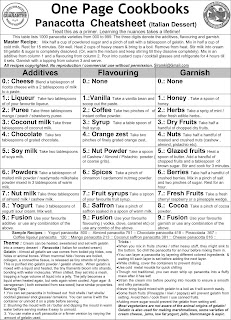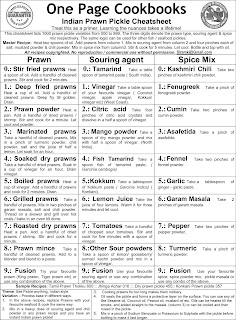Monday, November 29, 2010
Sunday, November 28, 2010
Friday, November 26, 2010
Saturday, November 20, 2010
Your comments on the new look please...
What do you think about the new look of One pagers ? They take 10 times longer to create, but if you really like the new look, I'll change them !
/Cheers
Ramki
Wednesday, November 17, 2010
One page cookbooks - Core beliefs
1. Cooking is simple, if you get the big picture straight. 2. Cooking is highly personal – you alone decide what tastes good. 3. Traditional recipes are general guidelines – not rigid instructions. 4. “The perfect way” to cook a dish is a myth. Even highly traditional dishes are cooked in many different ways. Recipes are alive and change with time and place. They are meant to be experimented with. 5. Cooking is more about fun, creativity & making healthy food than about fancy techniques, exotic ingredients and eye popping presentation. 6. Themes are universal. Each cuisine translates them with local Ingredients into recipes. 7. As with one, so with most others. If one flour can be turned into bread/ pasta / noodles / porridge / crepes /dumpling, most other flours can be too. 8. Anything goes with anything. It is a fallacy to believe that only a select few combinations work. |
10. Recipe purity is no different from racial purity or linguistic purity - It just does not exist. What is traditional today was esoteric a few decades back. Cuisines influence each other and evolve all the time. |
Sunday, November 14, 2010
International recipes eBook now available
My latest book " One page cookbook - International recipes" is finally done! It details fool proof recipes and variations of international sauces, dips, salads, soups, staples and desserts. If you want a sneak preview, mail me ( siramki at gmail dot com). Would love to have your comments before sending it off to the printers. This is a no strings attached offer for the first 50 respondents only !
/Cheers
Pasta Cheatsheet
Saturday, November 13, 2010
Friday, November 12, 2010
Tuesday, November 09, 2010
Friday, November 05, 2010
Sweets of India - Major families
Thursday, November 04, 2010
Chili sauces from across the world
Saturday, October 23, 2010
Friday, October 22, 2010
10 Easy Israeli Recipes
Thursday, October 21, 2010
Easy Jam Cheatsheet
Wednesday, October 20, 2010
Tuesday, October 19, 2010
Monday, October 18, 2010
Sunday, October 17, 2010
Saturday, October 16, 2010
Friday, October 15, 2010
Thursday, October 14, 2010
10 Major Gujarathi Dhokla/ Handvo families

For each dhokla family, look up the model recipes below for detailed instructions and pictures.
2. Cereal(s) grits + lentil flour Dhokla
3. Lentil(s) flour : E.g. Besan Dhokla , Mung dal Dhokla
4. Cereal(s) flour + lentil(s) flour Dhokla :
5. Soaked and ground cereal(s) + lentil batter Dhokla : E.g Rice + Urad dal + Chana dal Dhokla, Rice + Chana dal Dhokla
6. Soaked & ground Lentil(s) batter : E.g Chana dal Dhokla Or Chana Dal + Green peas Dhokla
7. Fresh / boiled / sprouted lentil(s) batter: E.g Green peas Dhokla
8. Soaked, dried and ground cereal(s) + lentil(s) flour : E.g Rice + Urad dal Dhokla
9. Roast and ground cereal(s) + lentil(s) E.g Rice + Urad dal Dhokla ( See Dhokla #2)
10. Processed cereals. E.g Rice flakes Dhokla, Rolled oats Dhokla
Wednesday, October 13, 2010
Tuesday, October 12, 2010
10 fun ways to get drunk !
Monday, October 11, 2010
Monday, October 04, 2010
Friday, October 01, 2010
10 Tanjore Curries

Due to Tanjore becoming the heartland of Tamil Brahmins, almost all its famous recipes are Brahmin recipes, with an almost total absence of Non vegetarian recipes.
Deep fried & spiced tuvar dal / chana dal paste becomes Vada. Steamed and crumbled, it becomes the Usili. In fact you can use leftover / store bought masal vadas, in this recipe in place of the steamed lentil paste and not many would spot the difference !
While researching for this book, I was engrossed in the bloody Muslim occupation of Madurai and Tanjore. Tamilnadu had been fortunate in escaping the massacares, temple razings and looting which plagued North India between 1000 and 1200 AD. Its luck ran out in 1311 when it experienced the brief but brutal Sultan occupation. . One of the sultans, Ghiyas-ud-Din Muhammad Damghani seems to have been especially brutal.
Ibn Batuta, the great Islamic traveller records: “…the Hindu prisoners were divided into four sections and taken to each of the four gates. There, on the stakes they had carried, the prisoners were impaled. Afterwards their wives were killed and tied by their hair to these poles. Children were massacred on the bosoms of their mothers. Then, the camp was raised, and they started cutting down the trees of another forest (for more impaling stakes). This is shameful conduct such as I have not known any other sovereign guilty of. It is for this that God hastened the death of Ghiyath-eddin”.
And “I was another time with the Sultan when a Hindu was brought into his presence. I rose hurriedly (to leave). He understood my reason, smiled, and ordered the hands and feet of the idolater to be cut off. On my return I found the unfortunate swimming in his blood”.
Wednesday, September 29, 2010
Tanjore Maratha Cereal - Lentil recipes

This amalgamation came at a price. Their language, culture and cuisine became so altered that they lost touch with their roots. (In fact, Tanjore marathis would hesitate to speak Marathi before a Maharashtrian for fear of being ridiculed !) This alone might not have been serious. But almost overnight, they were downgraded from rulers and large landowners to commoners, forced to earn their living. Some coped by rising as eminent administrators, but as a whole, the community suffered, dwindling from a peak of 250,000 to less than 500 today!
Tanjore Maratha Curries
 Tanjore Marathi rituals, cuisine and history are a little known but fascinating chapter in Tamil history. It is delightful to trace the evolution of a new community, cuisine and rituals. Migrations always seems to result in enrichment - prejudices lessen & new cuisines develop !
Tanjore Marathi rituals, cuisine and history are a little known but fascinating chapter in Tamil history. It is delightful to trace the evolution of a new community, cuisine and rituals. Migrations always seems to result in enrichment - prejudices lessen & new cuisines develop !
Wednesday, September 15, 2010
Cut wastage, make money !

Real data about restaurant performance is hard to come by. Irrespective of whether the restaurant is making a profit or loss, I see people invariably lie about figures.
So, here is something that might help - the past six month figures of an actual non-veg restaurant, which would go unnamed :)
It is amazing the amount of money you can make by just cutting wastage. Follow a few simple principles and you can dramatically increase profits.
1. Track all expenses every day.
2. Check stock every day
3. Get an item by item report printed at the end of each day and calculate the amount of stock that should have been consumed. Compare it with actual stock consumption. Charge the difference back to the kitchen.
4. If the customer has a complaint, never argue. Replace or refund.
5. Dramatically reduce gas usage by
a. Cooking covered
b. Presoaking
c. Pressure cooking
d. Regular cleaning of burners.
5. 'Taste' is a myth. It differs from person to person. Follow general cooking principles ( use fresh ingredients, do not use too much salt/ spices, do not burn stuff ) and you should be fine. On top of this remember the key characteristics for recipes - an Idli should be white and spongy, a parota whould be flaky and crumbly, a dosa should be crispy. Focus on these as you'll never be able to track the elusive taste. If you shoot for 'good' taste, you are dealing with a quantity you'll never measure or compare - and that is really frustrating !
6. Instead of focussing on the elusive taste, focus on standardisation. Standardise techniques and recipes so that you get an uniform result every time. Put the quality into equipment and techniques, rather than depending on the chef. Chef dependancy is the bane of many small restaurants ! Remember, standardisation beats taste anytime, as Mcdonald's demonstrates !
These principles were put in place during April and you can see the result by comparing March figureswith August figures. Sales goes up by around Rs.240,000 but production expenses rise by just Rs.60,000.
To put things in perspective, this restaurant does around Rs. 30,000 / day, whereas the Vadalapani Saravanabhavan, one of the top restaurants in Chennai, does around Rs.450,000 a day !
As a thumb rule, each 4 seater table in a restaurant generates around Rs.1000 a day. For reasonably well managed restaurants, it goes up to 2000 a day/ table. For popular restaurants, it can reach 4000 a day/ table.
If you are planning to open your own restaurant, remember it is easy to make money, if you put the right systems in place at the very beginning !
Saturday, September 04, 2010
Friday, September 03, 2010
The spirit of a cuisine....
This argument holds well for food too! Like religion, people can be very finicky about food - many still believe their cuisines are about using certain ingredients and cooking techniques. It is an immature cuisine which focuses too much on recipes. A mature cuisine does not bother about recipes - it evolves broad themes into which you can slot in any ingredient and cooking technique. For example one broad theme evolved by Indian cuisine is that " Knead an edible flour with a liquid, roll into thin sheets and cook on a hot skillet into a flat bread". The beauty of this theme is that it can slot in flours Indians never knew existed! It is the genius of a cuisine which can make sweeping generalizations like this. The spirit of a cuisine lives in its themes - not in its recipes. Using new ingredients / cooking techniques does not make a recipe unauthentic. When Indians settled abroad, it was natural for them to use fruits / vegetables available in the new lands into their recipes - does it make the recipe unIndian ? No !
The spirit of a cuisine is a reflection of the beliefs of a culture. A recipe becomes unauthentic only if it goes against the spirit of a cuisine. Stick true to the spirit of a cuisine and you don't have to worry about authenticity anymore !
If I had Carl Sagan's way with words, I wish I had said "How is it that hardly any major cookbook author has looked their cuisine and concluded, "This is better than we thought! Our cuisine is much richer than our elders said, grander, more subtle, more elegant. It can even accommodate ingredients and techniques we never knew about. It must be even greater than we dreamed"? Instead they say, "No, no, no! My cuisine is a little cuisine, made only with ingredients and techniques I know and I want it to stay that way !"
Tuesday, August 31, 2010
Monday, August 30, 2010
Saturday, August 28, 2010
10 Puttu ( Indian Couscous)

Lakshmi Wheat flour puttu
Rava Puttu
Yummy o Yummy’s Bread Puttu
Kamala’s Ragi Puttu
Pearl millet puttu
Maize puttu
Friday, August 27, 2010
Drinks Cheatsheet

Seena's Tender coconut drink #261
Soy peanut butter shake #178
Filipino Buko Juice #207
Non Alchoholic pina colada 003
Juicing vegetables #300
Lassi Cheatsheet #467
Milkshakes Cheatsheet #313
Juicing Fruit #600
Wednesday, August 25, 2010
Indian Seafood Pickle Cheatsheet
 Model Recipes
Model RecipesSayantani's Bengali Prawn pickle uses mango as a souring agent and mustard paste as a preservative. Her use of water, green chillies and coconut would no doubt make the pickle tasty, but would dramatically shorten the shelf life of the pickle. If you cut out coconut, replace green chilies with chili powder and water with vinegar, the shelf life would greatly improve.
Ramana Dukkipati's prawn pickle uses lemon juice as a preservative. Though warming lemon juice ( he has the innovative technique of adding lemon juice to hot pickle to warm it !) increases the shelf life, the water content in lemon juice does not permit the pickles to be stored for long. Replace lemon juice with vinegar or citric acid crystals dissolved in vinegar for a longer shelf life. Instead of rinsing and simmering prawns in water, using vinegar would dramatically improve shelf life.
Nisha's Tuna Pickle demonstrates there is just a thin line between a curry and a pickle.
Yummy Team's fish pickle reduces water content of the fresh fish first by blotting it with a tissue and then by deep frying it. However, Fish, green chilies, garlic and ginger do retain some of their water content, even after cooking. This water would shorten the shelf life, but the generous addition of vinegar balances it out.
If I am to judge pickles by how long they last, the easy winner is Addie's dry fish pickle. This would keep the longest as he only avoids using water in the recipe, but uses dry fish to ensure the recipe has virtually zero water. This pickle will easily last years in a refrigerator, getting better with age ! Remember, water is poison to pickles.
Think of any pickle as a really sour, really spicy curry, cooked with very little water ! In fact you can easily turn any curry into a pickle by adding a generous dose of souring agent & pickling spices.
Sunday, August 22, 2010
South Indian Sattu Mavu (Cereal based Energy Drink)
 Model Recipes :
Model Recipes :Seec’s Sattumavu with a cornucopia of cereals, lentils and flavourings shows how you can have all these powders as a sweet drink ( with milk and sugar) or as a savoury gruel ( with salt and buttermilk).
Ramya’s sattumavu uses the unusual medicinal rhizome, Vasambu (love flag).
Saturday, August 21, 2010
Indian Pickles Cheatsheet

Model recipes :
Indra’s red chili pickle, would last longer if vinegar is used to wash chilies instead of water, and the lemon juice is warmed before being added.
Divya’s Tomatillo pickle is a fine example of sticking true to the spirit of a recipe. Though her tomatillo pickle uses a ‘foreign’ ingredient, it will be no doubt accepted as an authentic Indian pickle.
Sireesha’s Andhra mango pickle. mixes the spices with the oil first and this paste is mixed in with the mangoes. The oil film would delay absorption of salt & spices by mango. A faster way would be to mix in salt with the mango pieces and wait for a couple of days so that the juices are drawn out and then mix in the spices, wait for a couple of days till they get absorbed and lastly to mix in the oil. Again, washing mango in vinegar instead of water would help getting a longer shelf life.
Friday, August 20, 2010
Instant Cereal Soup Powder Cheatsheet
 Model Recipes :
Model Recipes :Kamala's Kanji Podi with step by step pictures - but Oregano is not Omam ! It is the leaves of Oregano which are used and not its seeds.
Viji's gritty Kanji podi using healthy hand pounded rice demonstrates the large overlap soups and porridges have.
Wednesday, August 18, 2010
Tuesday, August 17, 2010
Powder anything - South Indian Style !

Model Recipes:
The simplest podi of them all – blend processed lentils with salt and chilies to a delicious powder ! Eat it mixed with rice or use it as a garnish for dry curries !
Swathi’s Kerala Style Coconut podi
Yummy team’s Dried prawn podi proving that the podis can accommodate any dried edibles. Their use of shallots would however shorten the life of the podi.
Monday, July 26, 2010
Saturday, July 24, 2010
Monday, July 12, 2010
Food Consultancy / Licensing / Crash Courses
Customised one page cookbooks now available for pressure cooker / microwave / mixie / masala & other cooking product manufacturers. Replace bulky recipe books with easy to refer One page cookbooks and watch your sales soar !
Twecipies
Blog Archive
-
▼
2010
(67)
-
▼
November
(15)
- West India Thali ( Gujarat & Rajasthan)
- North Indian Thali
- East Indian Thali ( Bengal, Orissa Bihar, Jharkhan...
- South Indian Thali ( Tamilnadu, Andhra, Kerala, Ka...
- The magical Indian Thali
- Your comments on the new look please...
- One page cookbooks - Core beliefs
- International recipes eBook now available
- Pasta Cheatsheet
- Salads Cheatsheet
- Spicy Dips Cheatsheet
- Papad Cheatsheet ( Sundried Indian crispies)
- Building blocks of World Cuisine
- Sweets of India - Major families
- Chili sauces from across the world
-
►
October
(17)
- Muthia Cheatsheet ( Gujarathi Steamed Dumplings)
- 10 Easy Israeli Recipes
- Easy Jam Cheatsheet
- Hummus Cheatsheet ( Middle east's favourite dip)
- Granita Cheatsheet ( Frozen Italian Dessert)
- Instant Sorbet Cheatsheet ( Frozen dessert)
- Instant Ice Cream Cheatsheet
- Fool Cheatsheet ( British Dessert)
- Chammanthi Cheatsheet ( Kerala Chutney )
- 10 Major Gujarathi Dhokla/ Handvo families
- Panacotta ( Italian Dessert) Cheatsheet
- 10 Chickpea based Indian Curries
- 10 fun ways to get drunk !
- Trifle Cheatsheet ( No Cook British Dessert)
- 10 Chickpea based Indian Breakfast recipes
- 10 Raw Meat recipes from across the world
- 10 Tanjore Curries
-
►
August
(10)
- 10 ways of eating whole seeds
- Puttu ( Indian Couscous) Cheatsheet
- 10 Puttu ( Indian Couscous)
- Drinks Cheatsheet
- Indian Seafood Pickle Cheatsheet
- South Indian Sattu Mavu (Cereal based Energy Drink)
- Indian Pickles Cheatsheet
- Instant Cereal Soup Powder Cheatsheet
- Indian Prawn Pickles
- Powder anything - South Indian Style !
-
▼
November
(15)
Cooking is fun - Duplication is a pain !
About Me

- Ramki
- Chennai, Tamilnadu, India
- Okay, let me start from the very beginning. 1500 crore years ago, with a Big Bang, the Universe is born. It expands dramatically. Hydrogen forms, contracts under gravity and lights up, forming stars. Some stars explode, dusting space with the building blocks of life. These condense into planets, one of which is Earth. Over time, self replicating molecules appear, multiply and become more complex. They create elaborate survival machines (cells, plants, animals). A variety of lifeforms evolve. Soon, humans arise, discover fire, invent language, agriculture and religion. Civilisations rise and fall. Alexander marches into India. Moguls establish an empire. Britain follows. Independence. Partition. Bloodshed. The license raj is in full sway. I'm born. India struggles to find its place. Liberalisation. The Internet arrives! I move from Tirupur to Chennai. Start a company. Expand into Malaysia, Singapore and the Middle East. Poof! Dot com bust. Funding dries up. Struggle. Retire. Discover the joy of cooking, giving, friendships and the pleasures of a simple life. Life seems less complicated. Pizza Republic, Pita Bite and Bhojan Express bloom !





































